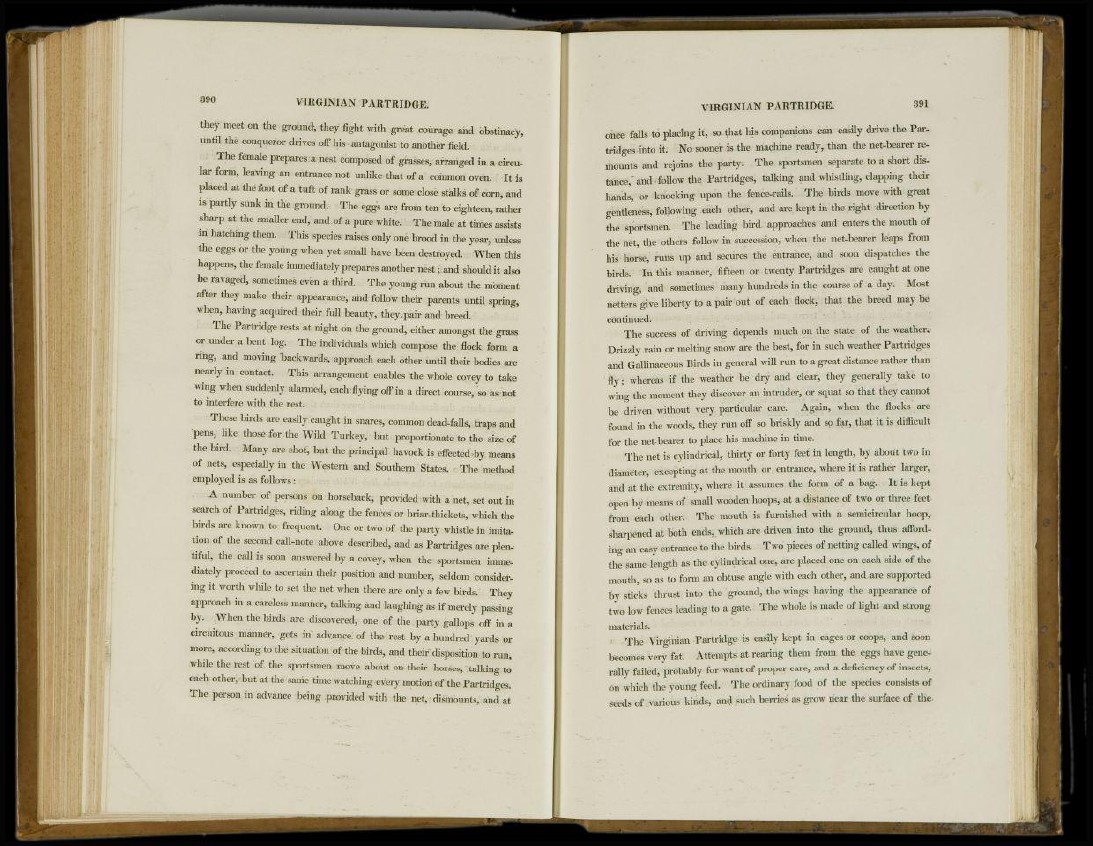
390 VIRGINIAN PARTRIDGE.
they meet on the ground-, they fight with great courage and obstinacy,
until the conqueror drives off his antagonist to another field.
The female prepares.a nest composed of grasses, arranged in a circular
form, leaving an entrance not unlike that of a common oven. It is
placed at the foot of a tuft of rank grass or some close stalks of corn, and
is partly sunk in the ground. The eggs are from ten to eighteen, rather
sharp at the smaller end, and of a pure white. The male at times assists
in hatching them. This species raises only one brood in the year, unless
the eggs or the young when yet small have been destroyed. When this
happens, the female immediately prepares another nest; and should it also
be ravaged, sometimes even a third. The young run about the moment
after they make their appearance, and follow their parents until spring,
when, having acquired their full beauty, they.pair and breed.
The Partridge rests at night on the ground, either amongst the grass
or under a bent log. The individuals which compose the flock form a
ring, and moving "backwards, approach each other until their bodies are
nearly in contact. This arrangement enables the whole covey to take
wing when suddenly alarmed, each flying off in a direct course, so as not
to interfere with the rest.
These birds are easily caught in snares, common dead-falls, traps and
penSj like those for the Wild Turkey, but proportionate to the size of
the bird. Many are shot, but the principal havock is effected by means
of nets, especially in the Western and Southern States. The method
employed is as follows:
A number of persons on horseback, provided with a net, set out in
search of Partridges, riding along the fences or briar-thickets, which the
birds are known to frequent. One or two of the party whistle in imitation
of the second call-note above described, and as Partridges are plentiful,
the call is soon answered by a covey, when the sportsmen immediately
proceed to ascertain their position and number, seldom considering
it worth while to set the net when there are only a few birds. They
approach in a careless manner, talking and laughing as if merely passing
by. When the birds are. discovered, one of the party gallops off in a
circuitous manner, gets in advance, of the rest by a hundred yards or
more, according to the situation of the birds, and their disposition to run,
while the rest of the sportsmen move about on their horses, talking to
each other, but at the same time watching every motion of the Partridges.
The person in advance being provided with the net, dismounts, and at
VIRGINIAN PARTRIDGE. 391
once falls to placing it, so that his companions can easily drive the Partridges
into it. No sooner is the machine ready, than the net-bearer remounts
and rejoins the party. The sportsmen separate to a short distance,
and • follow the Partridges, talking and whistling, clapping their
hands, or knocking upon the fence-rails. The birds move with great
gentleness, following each other, and are kept in the right direction by
the sportsmen. The leading bird approaches and enters the mouth of
the net, the others follow in succession, when the net-bearer leaps from
his horse, runs up and secures the entrance, and soon dispatches the
birds. In this manner, fifteen or twenty Partridges are caught at one
driving, and sometimes many hundreds in the course of a day. Most
netters give liberty to a pair out of each flock, that the breed may be
continued.
The success of driving depends much on the state of the weather.
Drizzly rain or melting snow are the best, for in such weather Partridges
and Gallinaceous Birds in general will run to a great distance rather than
fly; whereas if the weather be dry and clear, they generally take to
wing the moment they discover an intruder, or squat so that they cannot
be driven without very particular care. Again, when the flocks are
found in the woods, they run off so briskly and so far, that it is difficult
for the net-bearer to place his machine in time.
The net is cylindrical, thirty or forty feet in length, by about two in
diameter, excepting at the mouth or entrance, where it is rather larger,
and at the extremity, where it assumes the form of a bag. It is kept
open by means of small wooden hoops, at a distance of two or three feet
from each other. The mouth is furnished with a semicircular hoop,
sharpened at both ends, which are driven into the ground, thus affording
an easy entrance to the birds. Two pieces of netting called wings, of
the same length as the cylindrical one, are placed one on each side of the
mouth, so as to form an obtuse angle with each other, and are supported
by sticks thrust into the ground, the wings having the appearance of
two low fences leading to a gate. The whole is made of light and strong
materials.
The Virginian Partridge is easily kept in cages or coops, and soon
becomes very fat. Attempts at rearing them from the eggs have generally
failed, probably for want of proper care, and a deficiency of insects,
on which the young feed. The ordinary food of the species consists of
Seeds of various kinds, and such berries as grow near the surface of tlie.